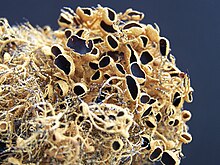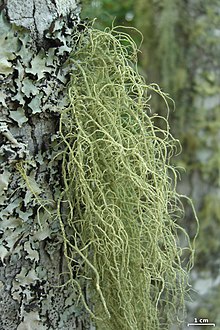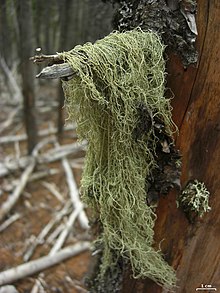Usnea
| Usnea | |
|---|---|

| |
| Usnea cavernosa | |
| Scientific classification | |
| Domain: | Eukaryota |
| Kingdom: | Fungi |
| Division: | Ascomycota |
| Class: | Lecanoromycetes |
| Order: | Lecanorales |
| Family: | Parmeliaceae |
| Genus: | Usnea Dill.ex.Adans.(1763) |
| Type species | |
| Usnea florida | |
| Species | |
|
Seetext | |
| Synonyms[1] | |
Usneais agenusof mostly pale grayish-greenfruticoselichensthat grow like leafless mini-shrubsortasselsanchoredon bark or twigs.[2]: 203 The genus is in the familyParmeliaceae.It grows all over the world. Members of the genus arecommonly calledold man's beard,beard lichen,orbeard moss.[2]: 203
Members of the genus are similar to those of the genusAlectoria.[2]: 148 A distinguishing test is that the branches ofUsneaare somewhat elastic, but the branches ofAlectoriasnap cleanly off.[2]: 148
Systematics[edit]
The genusUsneawas circumscribed byMichel Adansonin 1763.[3]He used the name designated byJohann Jacob Dillenius,whose earlier published description did not meet the rules ofvalid publicationas established by theInternational Code of Nomenclature for algae, fungi, and plants.However, he did not specify atype specimen;the speciesUsnea florida,moved to the genus byFriedrich Heinrich Wiggersin 1780, has been designated as thelectotype.[4]Since the establishment of the genus, hundreds ofUsneaspecies have been described. A three-volume series byJózef Motykapublished in 1936 and 1947 listed 451 species.[5]By 2006, the genus contained more than 600 species, which made it one of the largest genera within the family Parmeliaceae.[6]However, many former species are now regarded asmorphologicalvarieties and adaptations to local circumstances. The number of recognized species inFinlandhas decreased for this reason, for example, dropping from 34 in 1951 to 25 in 1963 and only 12 in 2000.[7]In addition, some formerUsneaspecies have been moved to other genera; for instance,Usnea longissimawas renamedDolichousnea longissimain 2004.[8]By 2022, the overall number of species assigned to the genus had dropped to 355.[9]
The nameUsneais probably derived from theArabicwordUshnah,meaning moss or lichen, though it may also mean "rope-like".[10][11]Based on a fossilUsneafound inBaltic amber,the genus is known to date back to at least the lateEocene,about 34 million years ago.[12]
Description[edit]
Usnealichens arefruticose.Structurally they are shrubby, often with many branches, and can be erect orpendent.[11]Some trailing species can grow to considerable size; strands ofUsnea longissima,for example, may exceed 3 meters (9.8 ft) in length.[13]Colours vary depending on the species, from straw-coloured, yellow-green or pale green through green or greyish-green to reddish or variegated red and green.[14]Unlike other similar-looking fruticose lichens, species in this genus have an elastic chord or axis running through the middle of the thallus that can be revealed by gently pulling a filament apart from either end.[15]
Usnealooks very similar to the plantSpanish moss,so much so that the latter's Latin name is derived from it (Tillandsia usneoides,the 'Usnea-likeTillandsia').
Distribution and habitat[edit]
Usnealichens are widely distributed in both the northern and southern hemisphere, in bothtemperateandtropicalregions.[14]
They appear in areas with low levels ofair pollution.They can often be found on the ground in areas with where trees or branches have recently been cut, such as orchards (afterpruning) and activeloggingareas.[16]
Ecology[edit]
Usnealichens reproduce viavegetativemeans throughfragmentation,asexualmeans throughsoredia,orsexualmeans throughascogoniumandspermatogonium.[17]The growth rate of lichens in nature is slow, but can be increased in laboratory conditions.[18]
Like other lichens,Usneaoften grows on sick or dying trees due to the pre-existing loss of canopy leaves, allowing for greater photosynthesis by the lichen's algae; this leads some gardeners to mistakenly blame the lichen for the tree's leaf loss and illness.[19]
Usneais very sensitive toair pollution,especiallysulfur dioxide.[20]Under poor growing conditions, such as areas high in pollution, they may grow no larger than a few millimetres, if they survive at all. Where the air is unpolluted, they can grow to 10–20 cm long. It can sometimes be used as abioindicator,because it tends to only grow in those regions where the air is clean,[21]and of high quality.
Uses[edit]
By humans[edit]
Traditional medicines[edit]
According to Paul Bergner, Author of Medical Herbalism, "theusnic acidinUsneais effective against gram positive bacteria such asStreptococcusandStaphylococcus,makingUsneaa valuable addition to herbal formulas for sore throats andskin infections.It is also effective against a bacterium that commonly causespneumonia."[22]
Bolivian traditional healers called theKallawayauseKaka sunkaindecoctionto cure lung problems. The lichen is macerated in alcohol and rubbed onto the body of those suffering from "nervous fragility".[16]
Some believe thatUsnea,in high concentrations, could possess some toxicity.[23]TheNational Toxicology Programevaluated the issue,[24]undertaking research involved feeding male and female rats and mice groundUsnealichens containing usnic acid for three months at various concentrations. Rats suffered severe toxicity, with significantliver damageobserved at various concentrations, while mice experienced liver toxicity, ovarian atrophy, and changes in reproductive cycles at higher doses. Additionally, both species showed weight loss at elevated exposure levels, and mice exhibited potentialgenetic damageafter two weeks at high concentrations. A safe exposure level was established at 60parts per million,below which no adverse effects were observed.[25]
Dyes[edit]
Usneaspecies have been used to create yellow, orange, green, blue, and purpledyesfor textiles.[26][27]This wide variety of possible colors can be achieved due to variations in chemical composition depending on the species, locality, andraceof a particular specimen. Specifically,Usneacan containthamnolic,squamatic,barbatic,salazinic,and alectorialic acids, all of which can affect dye color.[16]
Many indigenous peoples of Central and South America, including theTarahumuraandMapuchepeople, have a history of dyeing withUsnea,generally to obtain orange and brown hues. The Tarahumura use them to dyewoolblankets in brown andrussethues, and the Mapuche have usedUsnea floridato obtain orange. There is also anthropological evidence thatUsnea cocca soncawas historically used for dyeing in Peru, and a lichen calledcuaxapaxtlewas used near Mexico City.[16]
Cosmetics[edit]
Usnea barbatahas been used in cosmetic production for its antimicrobial and antifungal properties as a preservative anddeodorant.[28]
Firestarters[edit]
When dry,Usnealichens are flammable and can be used as afire starter.[29]
Food[edit]
SomeUsneaspecies have been used as food sources during times of scarcity. For example, people in Bosnia and Herzegovina ateUsnea barbataduring theBosnian War,particularly in the winter, when other plant material was not readily available.[30]They ground it into powdery "flour" to make bread or ate it as mush.[31]
By other organisms[edit]
Thenorthern parula,a species ofNew World warblerwhich breeds in North America, usesUsnealichens in the construction of itsnestin some parts of its range. Where these lichens have declined due to air pollution, the bird has also vanished as a breeding species.[32]
Species[edit]







- Usnea acromelanaStirt. (1898)
- Usnea alboverrucataG.N.Stevens (1999)
- Usnea amblyoclada(Müll.Arg.) Zahlbr. (1930)
- Usnea angulataAch. (1814)
- Usnea antarcticaDu Rietz (1926)
- Usnea araneaTruong & P.Clerc (2016)
- Usnea articulata(L.) Hoffm. (1796)
- Usnea aurantiaciparvulaA. Gerlach & P.Clerc (2017)
- Usnea austrocampestrisØvstedal (2012)[33]–Falkland Islands
- Usnea bismolliusculaZahlbr. (1930)
- Usnea boomianaP.Clerc (2015)
- Usnea brattiaeP.Clerc (2007)
- Usnea cavernosaTuck. (1850)
- Usnea cedrosianaP.Clerc (2007)
- Usnea ceratinaAch. (1810)
- Usnea chaetophoraStirt. (1883)
- Usnea cirrosaMotyka (1937)
- Usnea clercianaTruong (2016)
- Usnea confusaAsahina (1956)
- Usnea cornutaKörb. (1859)
- Usnea crenulataTruong & P.Clerc (2013)
- Usnea crocataTruong & P.Clerc (2011)
- Usnea cylindricaP.Clerc (2011)
- Usnea diplotypusVain. (1925)
- Usnea effusaG.N.Stevens (1999)
- Usnea elataMotyka (1936)
- Usnea elixiiG.N.Stevens (1991)
- Usnea esperantianaP.Clerc (1992)
- Usnea exiguaJ.M. Rodr. & P.Clerc (2011)
- Usnea filipendulaStirt. (1881)
- Usnea firmula(Stirt.) Motyka (1936)
- Usnea flammeaStirt. (1881)
- Usnea flavocardiaRäsänen (1936)
- Usnea flavorubescensTruong & P.Clerc (2012)
- Usnea fleigiaeA.Gerlach & P.Clerc (2017)
- Usnea florida(L.) Weber ex F.H.Wigg. (1780)
- Usnea floriformisC.W.Dodge (1948)
- Usnea foveataVain. (1928)
- Usnea fragilescensHav. ex Lynge (1921)
- Usnea fulvoreagens(Räsänen) Räsänen (1935)
- Usnea galapagonaTruong & P.Clerc (2011)
- Usnea geisslerianaP.Clerc (2006)
- Usnea glabrata(Ach.) Vain. (1915)
- Usnea glabrescens(Nyl. ex Vain.) Vain. (1925)
- Usnea glaucaMotyka (1930)
- Usnea grandisoraTruong & P.Clerc (2011)
- Usnea grandisporaA.Gerlach & P.Clerc (2017)
- Usnea himantodesStirt. (1883)
- Usnea hirta(L.) Weber ex F.H.Wigg. (1780)
- Usnea inermisMotyka (1936)
- Usnea intermedia(A.Massal.) Jatta (1909)
- Usnea kalbianaA.Gerlach & P.Clerc (2017)
- Usnea krogianaP.Clerc (2006)
- Usnea lambii(Imshaug) Wirtz & Lumbsch (2011)
- Usnea lapponicaVain. (1925)
- Usnea leanaBungartz, Truong & Herrera-Camp. (2018)
- Usnea lutiiJ.M.Rodr. & P.Clerc (2011)
- Usnea macaronesicaP.Clerc (2006)
- Usnea maculataStirt. (1882)
- Usnea marivelensis(Vain.) Motyka (1937)
- Usnea mayrhoferiHerrera-Camp., Bungartz, Truong & P.Clerc (2018)
- Usnea mekista(Stirt.) G.Awasthi (1985)
- Usnea messutiaeWirtz & Lumbsch (2011)
- Usnea molliusculaStirt. (1883)
- Usnea myrmaiacainaP.Clerc (2007)
- Usnea neuropogonoidesMotyka (1936)
- Usnea nidificaTaylor (1847)
- Usnea niduliferaMotyka (1937)
- Usnea oncodeoidesG.N.Stevens (1999)
- Usnea oncodesStirt. (1881)
- Usnea oreophilaA.Gerlach & P.Clerc (2019)
- Usnea pacificanaHalonen (2000)
- Usnea pallidocarpaWirtz & Lumbsch (2011)
- Usnea parafloridanaK.Mark, S.Will-Wolf & T.Randlane (2016)
- Usnea patricianaBungartz, Herrera-Camp. & P.Clerc (2018)
- Usnea pendulinaMotyka (1936)
- Usnea perplexansStirt. (1881)
- Usnea poliothrixKremp. (1874)
- Usnea praetervisa(Asahina) P.Clerc (2004)
- Usnea propaguliferaC.W. Dodge (1948)
- Usnea pulvinataFr. (1846)
- Usnea pycnocladaVain. (1909)
- Usnea pygmoidea(Asahina) Y. Ohmura (2011)
- Usnea quasirigidaLendemer & I.I.Tav. (2003)
- Usnea ramulosissimaG.N.Stevens & R.W.Rogers (1979)
- Usnea roseolaVain. (1921)
- Usnea rubicundaStirt. (1881)
- Usnea rubricornutaTruong & P.Clerc (2011)
- Usnea rubriglabrataTruong & P.Clerc (2016)
- Usnea rubrotinctaStirt. (1881)
- Usnea sanguineaSwinscow & Krog (1979)
- Usnea saxidilatataJ.M.Rodr. & P.Clerc (2011)
- Usnea scabrataNyl. (1875)
- Usnea scabridaTaylor (1844)
- Usnea silesiacaMotyka (1930)
- Usnea sphacelataR.Br. (1823)
- Usnea subalpinaG.N.Stevens (1999)
- Usnea subaraneaTruong & P.Clerc (2016)
- Usnea subcapillaris(D.J.Galloway) F.J. Walker (1985)
- Usnea subcomplectaTruong, P.Clerc & Herrera-Camp. (2018)
- Usnea subcornutaStirt. (1881)
- Usnea subdasaeaTruong & P.Clerc (2011)
- Usnea subeciliata(Motyka) Swinscow & Krog (1979)
- Usnea subflammeaP.Clerc (2006)
- Usnea subflaveolaTruong & P.Clerc (2013)
- Usnea subfloridanaStirt. (1882)
- Usnea subglabrataTruong & P.Clerc (2015)
- Usnea subparvulaA.Gerlach & P.Clerc (2017)
- Usnea subrubicundaP.Clerc (2011)
- Usnea subscabrosaNyl. ex Motyka (1937)
- Usnea tamborensis(Hepp) Motyka (1938)
- Usnea tayloriiHook.f. & Taylor (1844)
- Usnea torulosa(Müll.Arg.) Zahlbr. (1930)
- Usnea trachycarpa(Stirt.) Müll.Arg. (1889)
- Usnea ushuaiensis(I.M.Lamb) Wirtz, Printzen & Lumbsch (2008)
- Usnea viktorianaP.Clerc & Otte (2018)
- Usnea vrieseanaMont. & Bosch (1856)
- Usnea wasmuthiiRäsänen (1931)
- Usnea xanthopogaNyl. (1876)
References[edit]
- ^Species Fungorum.
- ^abcdField Guide to California Lichens, Stephen Sharnoff, Yale University Press, 2014,ISBN978-0-300-19500-2
- ^Adanson 1763,p. 616.
- ^Index Fungorum.
- ^Motyka 1936.
- ^Wirtz et al. 2006.
- ^Halonen 2000,p. 13.
- ^Articus 2004,p. 932.
- ^Wijayawardene et al. 2022,p. 151.
- ^Yavuz & Çobanoğlu 2010,p. 4.
- ^abDobson 2011,p. 445.
- ^Kaasalainen, Rikkinen & Schmidt 2020,p. 319.
- ^Brodo, Sharnoff & Sharnoff 2001,p. 11.
- ^abMcCarthy & Mallett 2004,p. 80.
- ^Brodo, Irwin M.; Sylvia Duran Sharnoff; Stephen Sharnoff; Canadian Museum of Nature (2001).Lichens of North America.Yale University Press. pp. 709–710.ISBN9780300082494.Retrieved6 December2012.
- ^abcdCardon, Dominique (2007).Natural Dyes: Sources, Tradition, Technology and Science.Technical advisors: Jo Kirby and Catherine Higgitt. London: Archetype Publications. pp. 524–525.ISBN978-1-904982-00-5.
- ^Marand, Sajan (5 January 2010)."Usnea".A Text Book of Botany: Vol. III.Calicut University. pp. 87–90.Retrieved6 December2012.
- ^"Optimization of Culture Conditions for LichenUsnea ghattensisG. Awasthi to Increase Biomass and Antioxidant Metabolite Production ".Food Technol. Biotechnol.47(1): 7–12. 2009.ISSN1330-9862.
- ^Brodo, Irwin M.; Sylvia Duran Sharnoff; Stephen Sharnoff; Canadian Museum of Nature (2001).Lichens of North America.Yale University Press. pp. 57–58.ISBN9780300082494.Retrieved6 December2012.
- ^Batty, Lesley C.; Hallberg, Kevin B., eds. (2010).Ecology of Industrial Pollution.Ecological Reviews. Cambridge University Press. p. 49.ISBN9780521514460.Retrieved4 December2012.
Usneaspp., at one time widespread and luxuriant, almost entirely disappeared from a major area of England and Wales covering at least 68 000 km² and at least 6 000 km² of lowland Scotland, mainly as a result of the increase in atmospheric pollution.
- ^"Usnea Lichens".www.lichens.net.Retrieved2018-04-06.
- ^"Lymphatic and antibiotic herbs".
- ^Jellin, JM; Gregory P.; Batz F.; Hitchens, K.; et al. (2000). "USNEA".Pharmacist's Letter/Prescriber's Letter Natural Medicines Comprehensive Database(3rd ed.). Stockton, CA: Therapeutic Research Facility. pp. 1048–1049.ISBN0967613647.
Adverse reactions are uncommon in appropriate amounts. Poisoning can be possible, although signs of poisoning have not yet been described.
- ^"Testing Status: Usnea lichen 09063".Testing Status of Agents at NTP.National Toxicology Program.Retrieved5 December2012.
- ^National Toxicology Program (NTP) (2022). NTP technical report on the toxicity studies ofUsnealichens containing (+/−)-usnic acid (CASRN 125-46-2) administered in feed to F344/N Nctr rats and B6C3F1/Nctr mice (Report). 105. Research Triangle Park, NC: National Toxicology Program.doi:10.22427/NTP-TOX-105.PMC9638892.
- ^Bolton 1991,p. 27.
- ^Casselman 2001,pp. 33, 36.
- ^Ash, Michael; Irene Ash (2004)."Lichen (Usnea barbata) extract".Handbook of Preservatives.Synapse Info Resources. p. 437.ISBN9781890595661.Retrieved6 December2012.
- ^Woodland Trust.
- ^Redzic, Barudanovic & Pilipovic 2010,p. 182.
- ^Redzic, Barudanovic & Pilipovic 2010,p. 180.
- ^DeGraaf & Yamasaki 2001,p. 219.
- ^Fryday, Alan M.; Øvstedal, Dag O. (2012). "New species, combinations and records of lichenized fungi from the Falkland Islands (Islas Malvinas)".The Lichenologist.44(4): 483–500.doi:10.1017/s0024282912000163.S2CID87490768.
Sources[edit]
- Adanson, Michel (1763).Familles des Plantes.Vol. v. 1-2. Paris: Chez Vincent.
- Articus, Kristina (November 2004)."Neuropogonand the phylogeny ofUsneas.l. (Parmeliaceae, Lichenized Ascomycetes) "(PDF).Taxon.53(4): 925–934.doi:10.2307/4135560.ISSN0040-0262.JSTOR4135560.
- "Beard Lichens (Usneaspecies) ".Woodland Trust.Retrieved27 May2023.
- Bolton, Eileen M. (1991).Lichens for Vegetable Dyeing(2 ed.). McMinnville, Oregon: Robin & Russ Handweavers.ISBN978-1-56659-001-3.
- Brodo, Irwin M.; Sharnoff, Sylvia Duran; Sharnoff, Stephen (2001).Lichens of North America.New Haven, CT: Yale University Press.ISBN978-0-300-08249-4.
- Casselman, Karen Diadick (2001).Lichen Dyes: The New Source Book.Mineola, NY: Dover Publications.ISBN978-0-486-41231-3.
- DeGraaf, Richard M.; Yamasaki, Mariko (2001).New England Wildlife.Lebanon NH: University Press of New England.ISBN0-87451-957-8.
- Dobson, Frank S. (2011).Lichens:An Illustrated Guide to the British and Irish Species.Slough: Richmond Publishing.ISBN978-0-85546-315-1.
- Halonen, Pekka (2000).Studies on the lichen genusUsneain East Fennoscandia and Pacific North America(PDF).Oulu, Finland: Oulu University Library.ISBN978-951-42-5523-6.ISSN0355-3191.
- Kaasalainen, Ulla; Rikkinen, Jouko; Schmidt, Alexander R. (July 2020)."Fossil Usnea and similar fruticose lichens from Palaeogene amber".The Lichenologist.52(4): 319–324.doi:10.1017/s0024282920000286.hdl:10138/318424.S2CID225403038.
- McCarthy, Patrick M.; Mallett, Katie, eds. (2004).Flora of Australia.Vol. 56A Lichens 4. Collingwood VIC:Australian Biological Resources Study& CSIRO Publishing.ISBN978-0-643-09056-9.
- Motyka, Józef (1936).Lichenum generis usnea.
- Redzic, Sulejman; Barudanovic, Senka; Pilipovic, Sasa (Winter 2010)."Wild Mushrooms and Lichens used as Human Food for Survival in War Conditions; Podrinje - Zepa Region (Bosnia and Herzegovina, W. Balkan)"(PDF).Human Ecology Review.17(2): 175–187.JSTOR24707664.
- "Usnea".Species Fungorum.Retrieved24 September2022.
- "Usnea".Index Fungorum.Retrieved21 September2022.
- Wijayawardene, N.N.; Hyde, K.D.; Dai, D.Q.; Sánchez-García, M.; Goto, B.T.; Saxena, R.K.; et al. (2022)."Outline of Fungi and fungus-like taxa – 2021".Mycosphere.13(1): 53–453.doi:10.5943/mycosphere/13/1/2.hdl:10481/76378.S2CID249054641.
- Wirtz, Nora; Printzen, Christian; Sancho, Leopoldo G.; Lumbsch, Thorsten H. (1 May 2006). "The phylogeny and classification ofNeuropogonandUsnea(Parmeliaceae, Ascomycota) revisited ".Taxon.55(2): 367–376.doi:10.2307/25065584.ISSN0040-0262.JSTOR25065584.
- Yavuz, Mustafa; Çobanoğlu, Gülşah (Summer 2010)."Ethnological uses and etymology of the wordUsneain Ebubekir Razi's "Liber Almansoris"".British Lichen Society Bulletin.106:3–12.
